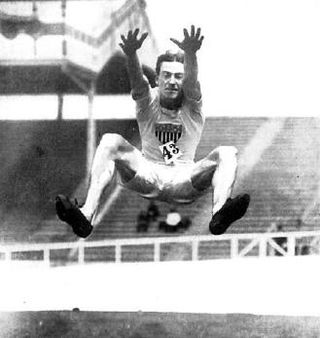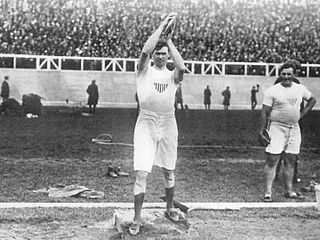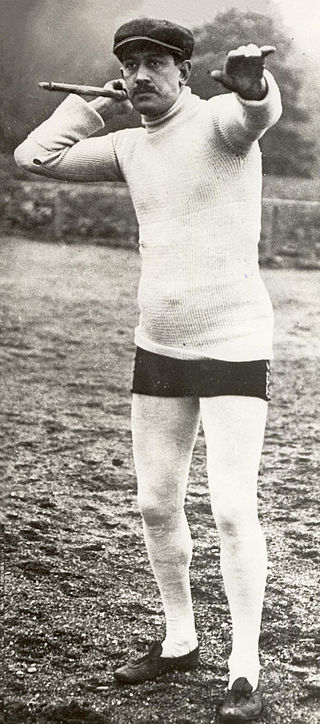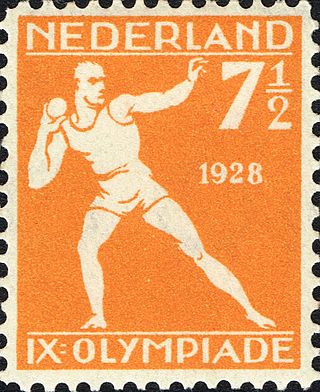
The javelin throw is a track and field event where the javelin, a spear about 2.5 m in length, is thrown as far as possible. The javelin thrower gains momentum by running within a predetermined area. Javelin throwing is an event of both the men's decathlon and the women's heptathlon.

At the 1908 Summer Olympics held in London, England, 26 athletics events were contested, all for men only. A total of 79 medals were awarded.

The men's 110 metres hurdles was the shorter of two hurdling events at the 1908 Summer Olympics in London. It was dominated by the American runners. The competition was held from Thursday, July 23, 1908, to Saturday, July 25, 1908. 25 hurdlers from ten nations competed. NOCs could enter up to 12 athletes. The event was won by Forrest Smithson of the United States, the fourth of five consecutive victories for the nation in the first five Olympic Games. It was also the third of four consecutive podium sweeps for the Americans in the event.

The men's long jump was one of six jumping events on the Athletics at the 1908 Summer Olympics programme in London. The competition was held on July 22, 1908. Thirty-two athletes from 9 nations competed. NOCs could enter up to 12 athletes. The event was won by Frank Irons of the United States, the nation's fourth consecutive victory in the first four Olympic Games. Calvin Bricker of Canada took bronze to break up the Americans' attempt at another sweep.

The men's triple jump was one of six jumping events on the Athletics at the 1908 Summer Olympics programme in London. The competition was held on 25 July 1908. Twenty athletes from eight nations competed. NOCs could enter up to 12 athletes. The event was won by Tim Ahearne of Great Britain, breaking a streak of three American victories in the triple jump. All three medal-winning nations were on the podium for the first time.
The men's pole vault was one of six jumping events on the athletics at the 1908 Summer Olympics programme in London. The competition was held on Friday, July 24, 1908. 15 pole vaulters from seven nations competed. It is the only one of the 111 events featured in 1908 to not have any competitors from the host nation. NOCs could enter up to 12 athletes. The event was won by Edward Cook and Alfred Carlton Gilbert of the United States, the nation's fourth consecutive victory in the men's pole vault. The tie was permitted, rather than a jump-off being held, due to the length of the competition. Similarly, bronze medals were awarded to all three men who had cleared 3.58 metres for third place. Sweden and Canada thus received their first medals in the pole vault, while the United States had the unusual distinction of winning three medals in an event but not sweeping.

The men's discus throw was one of six throwing events on the Athletics at the 1908 Summer Olympics programme in London. The competition was held on 16 July 1908. 42 throwers from eleven nations competed. NOCs could enter up to 12 athletes. The event was won by Martin Sheridan of the United States, his second consecutive victory in the event. The Americans completed their first sweep in the discus throw, with Merritt Giffin taking silver and Bill Horr bronze.

The men's Greek-style discus throw was one of six throwing events on the Athletics at the 1908 Summer Olympics programme in London. The competition was held on 18 July 1908. In the Greek-style event, throwers hurled the discus from atop a rectangular platform raised above the ground. Throwing style was strictly prescribed by the rules of the event. The event had been contested at the 1906 Summer Olympics, but was not held again after 1908. NOCs could enter up to 12 athletes.

The men's hammer throw was one of six throwing events on the Athletics at the 1908 Summer Olympics programme in London. The competition was held on July 14, 1908. 19 throwers from eight nations competed. NOCs could enter up to 12 athletes. The event was won by American John Flanagan, his third consecutive victory in the event. He was the first man to win three medals in the hammer throw and, as of the 2016 Games, the only one to win three gold medals in the event. The silver medal went to fellow American Matt McGrath. Con Walsh of Canada took bronze and became the first athlete not from the United States to win a medal in the event, as the Americans had swept the podium in both 1900 and 1904. The three medalists were all part of the Irish Whales.
The men's freestyle javelin throw was one of six throwing events on the Athletics at the 1908 Summer Olympics programme in London. The javelin could be held anywhere, as opposed to the standard javelin throw which required the javelin to be held by a grip in the middle. This was the only time such a "freestyle" event was held at the Olympics. The competition was held on 15 July 1908. 33 throwers from nine nations competed. NOCs could enter up to 12 athletes.

The men's shot put was one of six throwing events on the Athletics at the 1908 Summer Olympics programme in London. The competition was held on July 16, 1908. 25 shot putters from eight nations competed. NOCs could enter up to 12 athletes. The event was won by Ralph Rose, successfully defending his title from 1904 and making it four consecutive Games that the event was won by an American. The two-Games streak of sweeps in 1900 and 1904 ended, however, as Denis Horgan of Great Britain took silver. Johnny Garrels of the United States took bronze. Rose was the second man to win two medals in the shot put ; Wesley Coe nearly was the third as he ended up in 4th place, only 11 centimetres behind Garrels.

Eric Otto Valdemar Lemming was a Swedish track and field athlete who competed at the 1900, 1906, 1908 and 1912 Olympics in a wide variety of events, which mostly involved throwing and jumping. He had his best results in the javelin throw, which he won at the 1906–1912 Games, and in which he set multiple world records between 1899 and 1912. His last record, measured at 62.32 m, was ratified by the International Association of Athletics Federations as the first official world record.
Urho Pellervo Peltonen was a Finnish athlete who competed mainly in the javelin throw.
Móric "Mór" Kóczán was a Slovak–Hungarian athlete and Calvinist pastor. Specialized for the throwing events, his best results came in the javelin throw, having won five Hungarian championship titles between 1911 and 1918. Kóczán competed for Hungary at the 1908 Summer Olympics and 1912 Summer Olympics. He produced his best performance in 1912 by winning the bronze medal in the javelin throw event.

The men's javelin throw was a track and field athletics event held as part of the athletics at the 1912 Summer Olympics programme. It was the second appearance of the event, but in 1908 it was a standing throw with no run up. The competition was held on Saturday, July 6, 1912. Twenty-five javelin throwers from seven nations competed. NOCs could enter up to 12 athletes.

The men's javelin throw event was part of the track and field athletics programme at the 1920 Summer Olympics. The competition was held on Sunday, August 15, 1920. Twenty-five javelin throwers from twelve nations competed.

The men's shot put event was part of the track and field athletics programme at the 1928 Summer Olympics. The competition was held on Sunday, 29 July 1928. Twenty-two shot putters from 14 nations competed. The maximum number of athletes per nation was 4. The event was won by Johnny Kuck of the United States, the nation's second consecutive, and seventh overall, victory in the men's shot put. Kuck set a new world record. Future film star Bruce Bennett, then still using his birth name Herman Brix, took silver. Emil Hirschfeld won Germany's first shot put medal with bronze.

The javelin throw at the Summer Olympics is one of four track and field throwing events held at the multi-sport event. The men's javelin throw has been present on the Olympic athletics programme since 1908, being the last of the current throwing events to feature at the Olympics after the shot put, discus throw and hammer throw. The women's event was first contested at the 1932 Olympics, becoming the second women's throws event after the discus in 1928.

The pole vault at the Summer Olympics is grouped among the four track and field jumping events held at the multi-sport event. The men's pole vault has been present on the Olympic athletics programme since the first Summer Olympics in 1896. The women's event is one of the latest additions to the programme, first being contested at the 2000 Summer Olympics – along with the addition of the hammer throw, this brought the women's field event programme to parity with the men's.

Combined events at the Summer Olympics have been contested in several formats at the multi-sport event. There are two combined track and field events in the current Olympic athletics programme: a men's decathlon and a women's heptathlon.
















